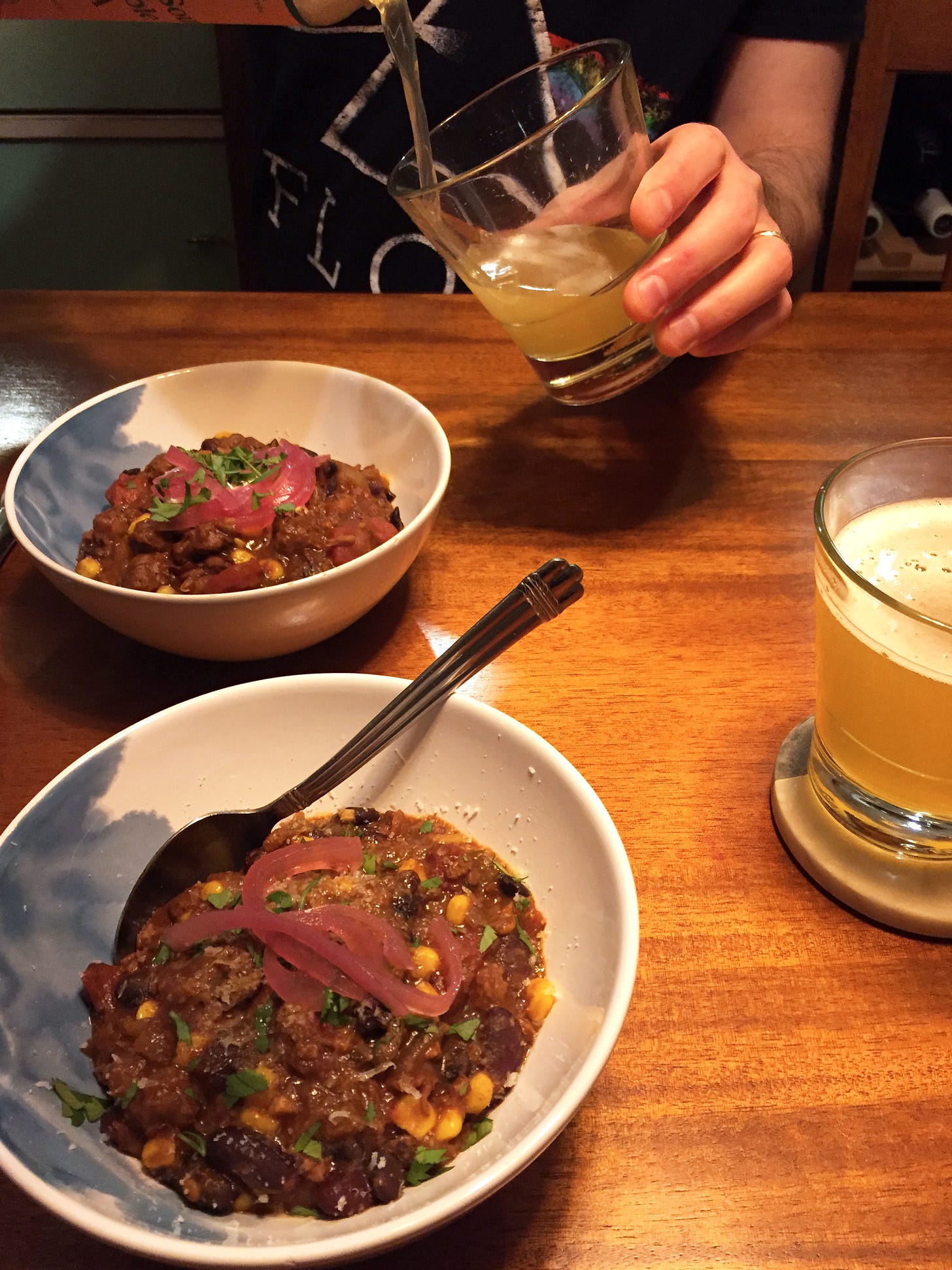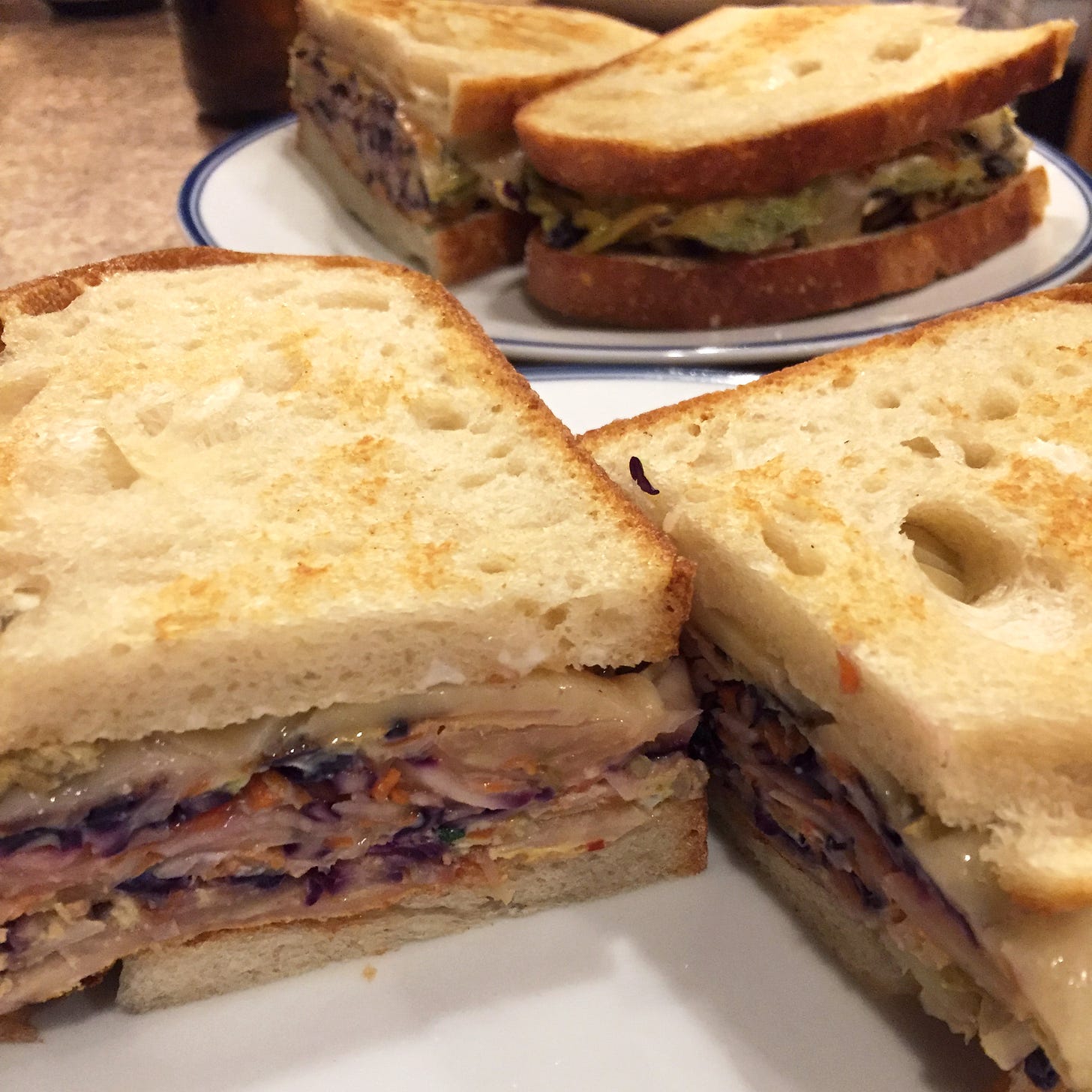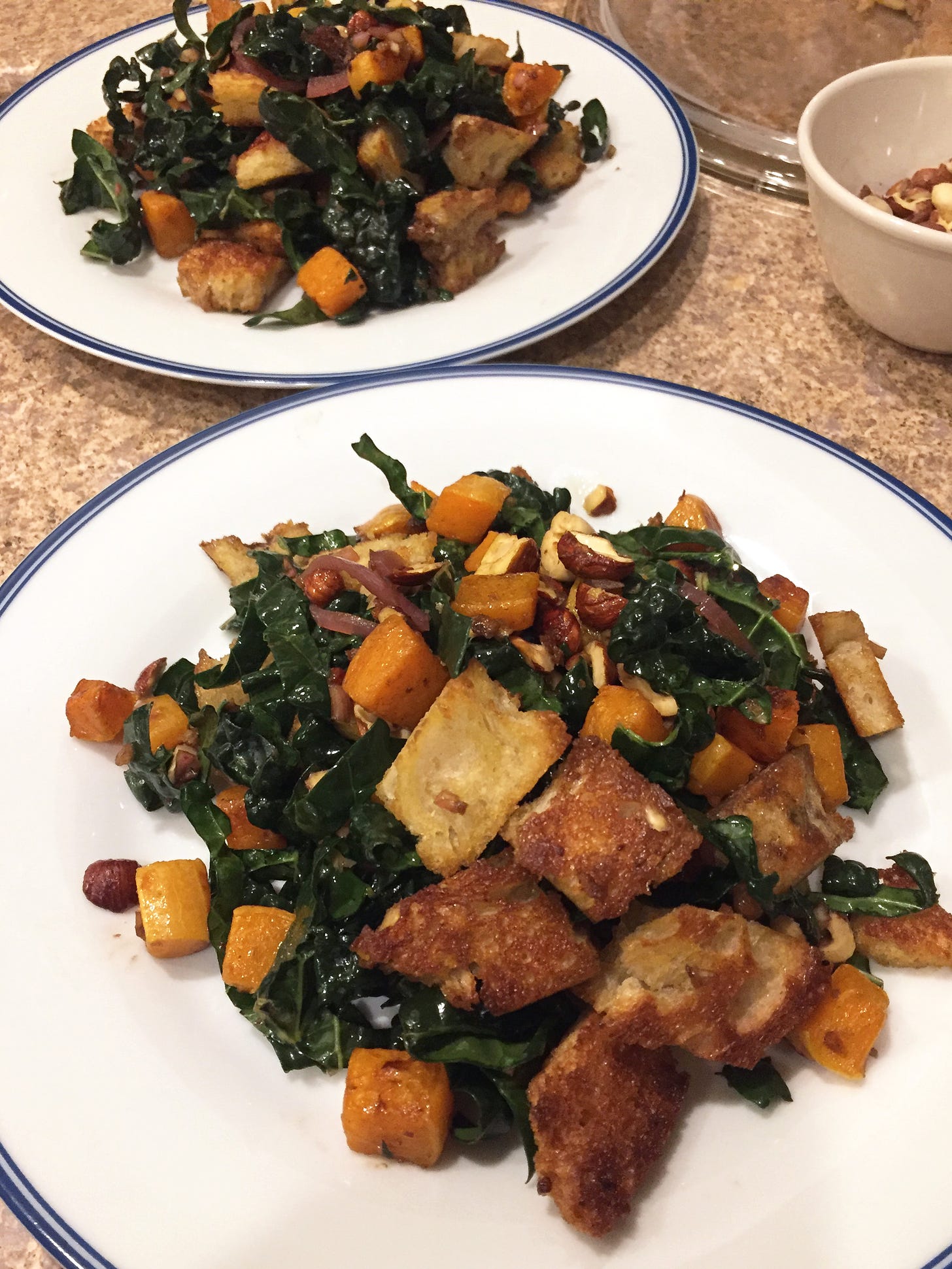This week has been very challenging and disorganized, and I know I’m not the only one feeling it. Is it the retrograde? The weather? Sheer exhaustion with the pandemic? All of the above? I’m not certain, but it felt like every time I turned around to do something, there was something going wrong or something else that needed my attention, and things that shouldn’t be complicated or confusing were being made unnecessarily difficult. By the end of Tuesday, I was exhausted, and thinking to myself, “Thank god it’ll be Friday tomorrow.” Well. At least it is finally the actual Friday, and may next week bring us all slightly fewer rake handles to the face.
Chili is one of those foods I’ll forget exists for weeks or months, be reminded of, and then suddenly, it’s all I want. My usual go-to is the squash & red lentil chili with black beans, which I’ve written about before, but I was craving something more diner-esque. I have a three-bean chili recipe written on an index card I’ve been using for so long that I don’t really know where the original recipe inspiration came from (knowing me circa 2009, probably allrecipes or food.com). I like it because it’s really good as is, but also lends itself well to making substitutions or changes based on what you’ve got around— chili should be a pantry meal, not something you go to the grocery store to buy ingredients for. I’ve included my recipe toward the end of this newsletter.
The key elements to this chili are a couple tablespoons of molasses for sweetness, fire-roasted tomatoes for depth, and corn for colour and crunch. I normally make it with mushrooms and bell peppers for some texture variety and bulk, but we were out of both and I was searching for that “Mom’s slow-cooked chili” vibe, so I used a pack of Beyond vegan ground, which was excellent. Since the packet is 12 ounces and not a pound, the chili was meaty but not so meaty that it felt like a can of Stagg’s, where you get approximately 5 kidney beans floating in a bowl of sauce and ground beef. The jalapeños I used turned out to be pretty weak, so at the end Jeff dumped in some Pain is Good hot sauce, making it just perfect, especially with a bit of manchego on top.
I needed to use up some elderly cabbage from my produce drawer, and I was thrilled to have an excuse to make this gilgeori toast I’ve had saved for some time. The main component of this Korean street-vendor style egg sandwich is shredded cabbage and carrot mixed with egg, which is then lightly fried to create a patty that is texturally somewhere between okonomiyaki and an omelette. It was really quick to make (I used the food processor to shred the vegetables), and I threw in some kimchi too for a little extra seasoning. Pan-frying the bread instead of toasting normally makes it reminiscent of a grilled cheese sandwich, and although reading the recipe I wasn’t 100% sold on the sugar aspect, it turned out to be oddly satisfying. This made for a unique breakfast-for-dinner situation that was super filling, with a nice variety of flavours and textures all within a single sandwich. I recommend it if you’ve got some extra cabbage around— and don’t skip the ketchup!
You ever just… casually spend two hours making dinner? There is absolutely no reason that a salad should take this long to make, but on Tuesday, the stars deemed this to be my fate. I was making the phenomenal autumn panzanella from Salt Fat Acid Heat, which I’ve made several times before, but I guess usually I have already made the croutons, or the dressing, or roasted the squash, or some combination of these. And I definitely have never had to crack the hazelnuts by hand before (my roommate scored a huge bag from work around Christmas, and told us to feel free to have some). I’m embarrassed to think how much time— and hand strength— it took me to get roughly ¾ of a cup, and I’m still finding bits of hazelnut shells that went careening halfway across the house.
However, this salad, lovingly known in my house as “the bread salad”, is worth it. A mix of crisp and slightly softened croutons, browned pieces of butternut squash, crunchy toasted hazelnuts, and tender lacinato kale, all in the brown butter vinaigrette that has both ruined and improved my life. The recipe also includes fried sage leaves, but after how long I spent prepping the other elements, I decided the return on investment was too low to be bothered with this time. And I was out of red onion so I couldn’t do the macerated onion aspect of this salad, but I always have pickled red onion in the fridge which is, in my pickle-loving opinion, even better.
After the success of the sheet pan cauliflower and pancetta a couple of weeks ago, and because I still had castelvetrano olives left, I tried a similar dish: a gratin of cauliflower, olives, and parmesan. I used this recipe as inspiration but changed basically everything about it because I was immediately skeptical of the fact that it has you boiling the cauliflower for five minutes before roasting it for another 25. Instead I roasted the cauliflower and onion together in olive oil and smoked paprika for 20 minutes at 425°, which had the added bonus of making the kitchen smell amazing. In a cast iron pan, I cooked the garlic with some chili flakes, and added a few kale leaves for colour. I used a mix of the castelvetrano olives and kalamata, and blended together pecorino, parmesan, and gruyere for the gratin.
The joy of cooking with cast iron is you can go straight from stove to oven, so I assembled it right in there and baked for 8 minutes at 425°, and then two minutes under the broiler to brown the cheese. It was a tasty way to use up a cauliflower, full of delicious roasted onion slices and briny olive pieces, but I do have two small regrets. One, that I didn’t account for how much saltier the olives in the original recipe would be (I would have added more kalamatas, or a couple of anchovies); and two, that I didn’t have it together enough to remember to make a salmon filet or some vegan sausage, because this just wasn’t as filling as I wanted it to be. Next time, Gadget…
THREE-BEAN CHILI
1 medium onion, diced
2 jalapeños, or 1 spicier pepper like serrano, finely chopped
8-12 oz ground round OR 8 oz chopped mushrooms and red pepper
2-3 garlic cloves, minced
1 tbsp chili powder
1 tsp each cumin and oregano
3 tbsp tomato paste
1 14-oz can fire-roasted diced or crushed tomatoes (depending what texture you like)
1 tsp salt, or to taste
2 tbsp molasses
3 14-oz cans of beans, rinsed and drained, any kind (I use kidney, black & navy)
1 cup corn
hot sauce and fresh ground pepper to taste
juice of half a lemon or lime
any combo of sour cream, avocado, pickled onion, cheese, and cilantro, to serve
Heat a large pot over medium and add 2 tbsp olive oil. Fry the onion and the jalapeño until slightly softened, 3-4 min. Add the ground round or chopped mushrooms & pepper, and cook either until the meat is browned or until the mushrooms have softened and released some of their water, 5-8 min. Add the garlic and the spices and toss to coat, until fragrant, about 1 min.
Add the canned tomatoes, salt, and tomato paste, stirring to deglaze the pan and dissolve the paste. Without rinsing it, fill the tomato can with water. Add the beans and molasses, some ground pepper, and enough of the water so that everything is just covered, and bring to a simmer. Once it starts to bubble, stir in the corn and keep it at a low simmer, partially covered, for 20-30 minutes. Add more of the water if it gets too thick, or take the lid off for a bit if it’s too thin.
Taste for salt and heat, and add hot sauce and more pepper if needed. Add the citrus juice to balance, and serve with the toppings. Makes about 4 good-size servings.
Media:
Due to the aforementioned sheer brain chaos this week, I don’t have any articles to talk about! Though, I’ve been watching a lot of Star Trek: The Next Generation and I’ve been taking note of the way they talk about using a replicator versus actually cooking food. Characters often note how food and drink produced by the replicator isn’t exactly like the real thing, and fails to satisfy in some respects, and yet anyone who cooks is viewed as either hopelessly old-fashioned, a little zany, or immensely talented, because so few people bother to do it. I don’t really have a thorough analysis on this or anything, but I find it a fascinating interpretation of what our food future could look like. What will lab-grown meats be like compared to the real thing? When certain produce items or trees become endangered or extinct due to climate change, what will we replace them with?
And as an aside, I’m sure there are people who, more than ten months into the pandemic, would happily eat a replicator meal regardless of whether it was as good as ‘real’ food or not, simply for the luxury of eating something you didn’t have to shop for and cook yourself.
Thanks for reading— if you enjoyed this newsletter, please share it with someone new! I like providing this to you for free, but it does still involve time and effort, so donations I can use towards cookbooks or future treats are much appreciated. Lastly, I take joy in the fact that this account shares my issue with meal prep companies.







